2016 Hyundai Santa Fe child restraint
[x] Cancel search: child restraintPage 72 of 699
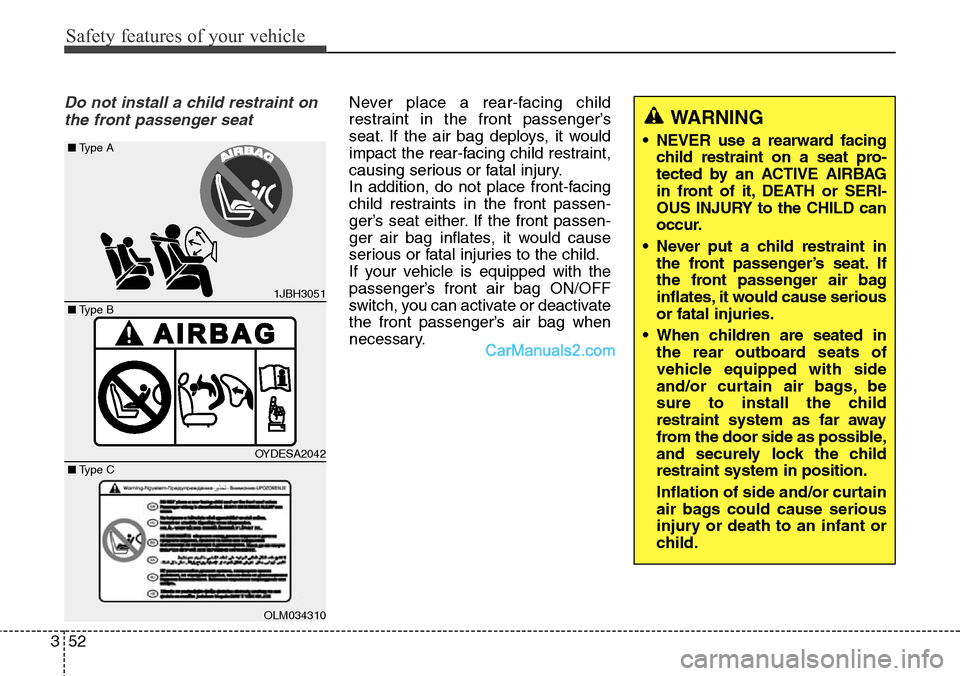
Safety features of your vehicle
52 3
Do not install a child restraint on
the front passenger seatNever place a rear-facing child
restraint in the front passenger’s
seat. If the air bag deploys, it would
impact the rear-facing child restraint,
causing serious or fatal injury.
In addition, do not place front-facing
child restraints in the front passen-
ger’s seat either. If the front passen-
ger air bag inflates, it would cause
serious or fatal injuries to the child.
If your vehicle is equipped with the
passenger’s front air bag ON/OFF
switch, you can activate or deactivate
the front passenger’s air bag when
necessary.
WARNING
• NEVER use a rearward facing
child restraint on a seat pro-
tected by an ACTIVE AIRBAG
in front of it, DEATH or SERI-
OUS INJURY to the CHILD can
occur.
• Never put a child restraint in
the front passenger’s seat. If
the front passenger air bag
inflates, it would cause serious
or fatal injuries.
• When children are seated in
the rear outboard seats of
vehicle equipped with side
and/or curtain air bags, be
sure to install the child
restraint system as far away
from the door side as possible,
and securely lock the child
restraint system in position.
Inflation of side and/or curtain
air bags could cause serious
injury or death to an infant or
child.
1JBH3051
OYDESA2042
OLM034310
■Type B ■Type A
■Type C
Page 79 of 699
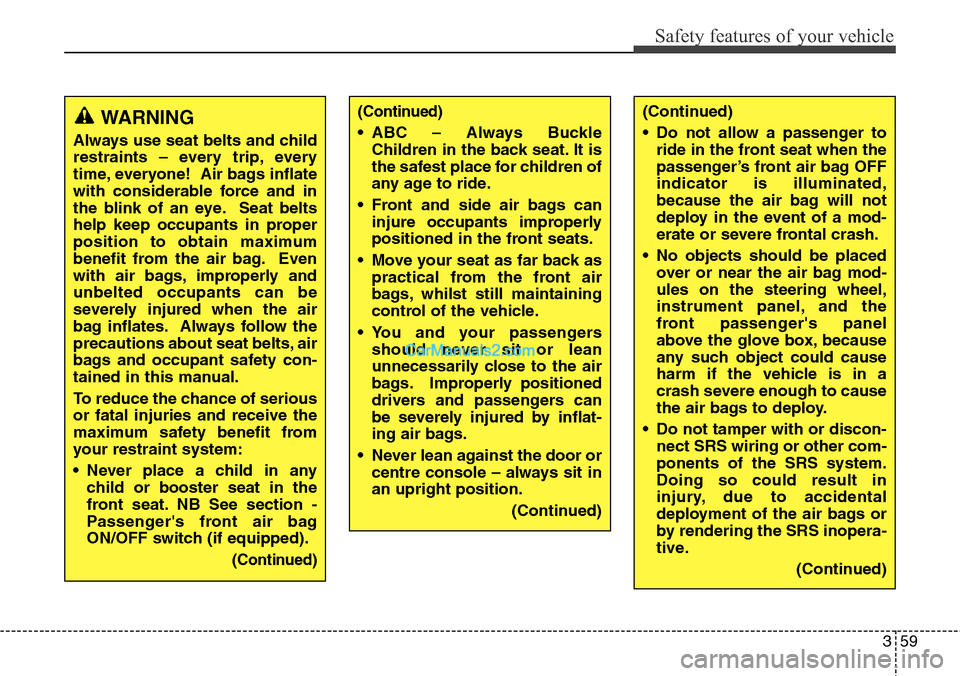
359
Safety features of your vehicle
WARNING
Always use seat belts and child
restraints – every trip, every
time, everyone! Air bags inflate
with considerable force and in
the blink of an eye. Seat belts
help keep occupants in proper
position to obtain maximum
benefit from the air bag. Even
with air bags, improperly and
unbelted occupants can be
severely injured when the air
bag inflates. Always follow the
precautions about seat belts, air
bags and occupant safety con-
tained in this manual.
To reduce the chance of serious
or fatal injuries and receive the
maximum safety benefit from
your restraint system:
• Never place a child in any
child or booster seat in the
front seat. NB See section -
Passenger's front air bag
ON/OFF switch (if equipped).
(Continued)
(Continued)
• ABC – Always Buckle
Children in the back seat. It is
the safest place for children of
any age to ride.
• Front and side air bags can
injure occupants improperly
positioned in the front seats.
• Move your seat as far back as
practical from the front air
bags, whilst still maintaining
control of the vehicle.
• You and your passengers
should never sit or lean
unnecessarily close to the air
bags. Improperly positioned
drivers and passengers can
be severely injured by inflat-
ing air bags.
• Never lean against the door or
centre console – always sit in
an upright position.
(Continued)
(Continued)
• Do not allow a passenger to
ride in the front seat when the
passenger’s front air bag OFF
indicator is illuminated,
because the air bag will not
deploy in the event of a mod-
erate or severe frontal crash.
• No objects should be placed
over or near the air bag mod-
ules on the steering wheel,
instrument panel, and the
front passenger's panel
above the glove box, because
any such object could cause
harm if the vehicle is in a
crash severe enough to cause
the air bags to deploy.
• Do not tamper with or discon-
nect SRS wiring or other com-
ponents of the SRS system.
Doing so could result in
injury, due to accidental
deployment of the air bags or
by rendering the SRS inopera-
tive.
(Continued)
Page 80 of 699
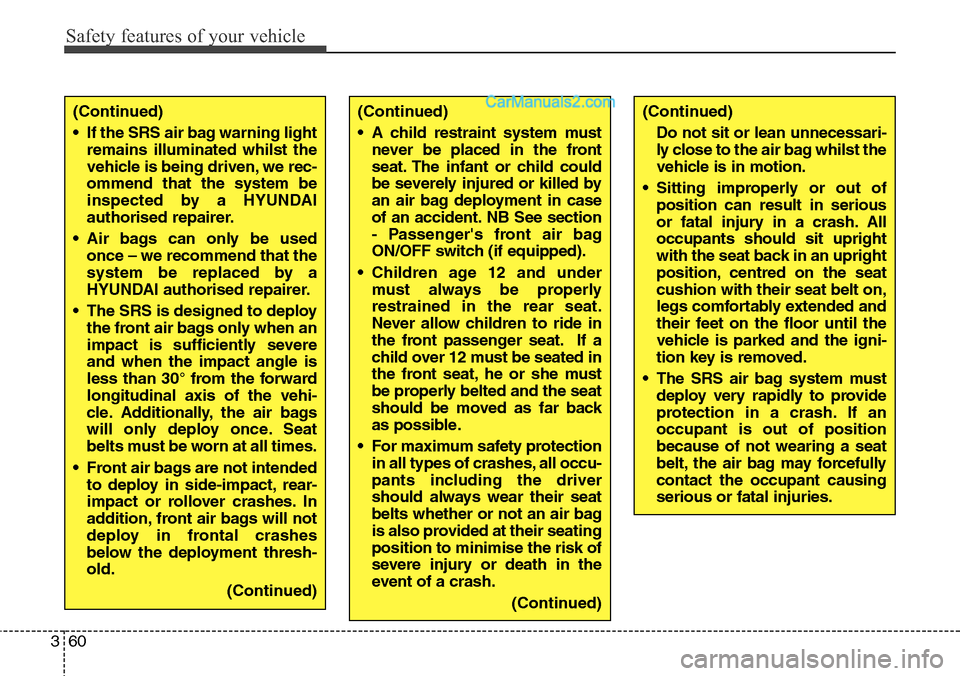
Safety features of your vehicle
60 3
(Continued)
• If the SRS air bag warning light
remains illuminated whilst the
vehicle is being driven, we rec-
ommend that the system be
inspected by a HYUNDAI
authorised repairer.
• Air bags can only be used
once – we recommend that the
system be replaced by a
HYUNDAI authorised repairer.
• The SRS is designed to deploy
the front air bags only when an
impact is sufficiently severe
and when the impact angle is
less than 30° from the forward
longitudinal axis of the vehi-
cle. Additionally, the air bags
will only deploy once. Seat
belts must be worn at all times.
• Front air bags are not intended
to deploy in side-impact, rear-
impact or rollover crashes. In
addition, front air bags will not
deploy in frontal crashes
below the deployment thresh-
old.
(Continued)(Continued)
• A child restraint system must
never be placed in the front
seat. The infant or child could
be severely injured or killed by
an air bag deployment in case
of an accident. NB See section
- Passenger's front air bag
ON/OFF switch (if equipped).
• Children age 12 and under
must always be properly
restrained in the rear seat.
Never allow children to ride in
the front passenger seat. If a
child over 12 must be seated in
the front seat, he or she must
be properly belted and the seat
should be moved as far back
as possible.
• For maximum safety protection
in all types of crashes, all occu-
pants including the driver
should always wear their seat
belts whether or not an air bag
is also provided at their seating
position to minimise the risk of
severe injury or death in the
event of a crash.
(Continued)(Continued)
Do not sit or lean unnecessari-
ly close to the air bag whilst the
vehicle is in motion.
• Sitting improperly or out of
position can result in serious
or fatal injury in a crash. All
occupants should sit upright
with the seat back in an upright
position, centred on the seat
cushion with their seat belt on,
legs comfortably extended and
their feet on the floor until the
vehicle is parked and the igni-
tion key is removed.
• The SRS air bag system must
deploy very rapidly to provide
protection in a crash. If an
occupant is out of position
because of not wearing a seat
belt, the air bag may forcefully
contact the occupant causing
serious or fatal injuries.
Page 83 of 699

363
Safety features of your vehicle
(Continued)
• If the SRS air bag warning
light blinks or does not illumi-
nate when the ignition switch
is turned to the ON position,
or if it illuminates whilst the
vehicle is being driven, we
recommend that the system
be inspected by a HYUNDAI
authorised repairer.(Continued)
• Even though your vehicle is
equipped with the passen-
ger's front air bag ON/OFF
switch, do not install a child
restraint system in the front
passenger's seat. A child
restraint system must never
be placed in the front seat
other than that explained in
section - Passenger's front air
bag ON/OFF switch (if
equipped). Children who are
too large for child restraint
systems should always occu-
py the rear seat and use the
available lap/shoulder belts.
Children are afforded the
most safety in the event of an
accident when they are
restrained by a proper
restraint system in the rear
seat.
• As soon as the child seat is
no longer needed on the front
passenger's seat, reactivate
the front passenger's air bag.WARNING
• The driver is responsible for
the proper position of the pas-
senger’s front air bag ON/OFF
switch.
• Deactivate the passenger's
front air bag only when the
ignition switch is switched off,
or the malfunction may occur
in the SRS Control Module.
And there may be a danger
that the driver's and/or front
passenger’s and/or side and
curtain air bag may fail to trig-
ger, or not trigger correctly
during a collision.
• Never install a rearward fac-
ing child seat on the front pas-
senger's seat unless the pas-
senger's front air bag has
been deactivated. The infant
or child could be severely
injured or killed by an air bag
deployment in case of an acci-
dent.
(Continued)
Page 86 of 699
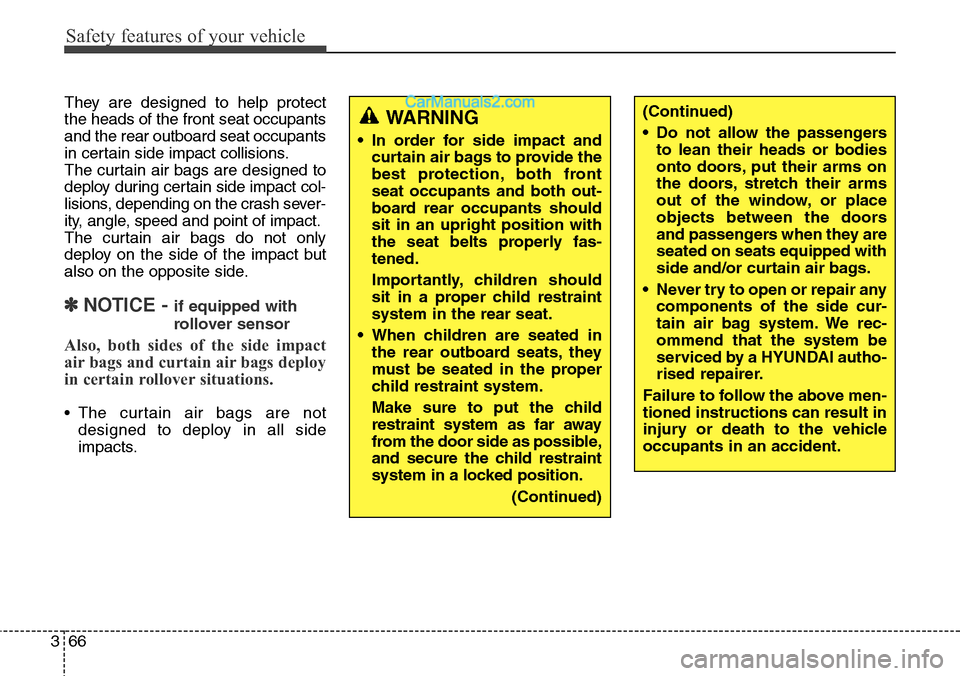
Safety features of your vehicle
66 3
They are designed to help protect
the heads of the front seat occupants
and the rear outboard seat occupants
in certain side impact collisions.
The curtain air bags are designed to
deploy during certain side impact col-
lisions, depending on the crash sever-
ity, angle, speed and point of impact.
The curtain air bags do not only
deploy on the side of the impact but
also on the opposite side.
✽NOTICE - if equipped with
rollover sensor
Also, both sides of the side impact
air bags and curtain air bags deploy
in certain rollover situations.
• The curtain air bags are not
designed to deploy in all side
impacts.
(Continued)
• Do not allow the passengers
to lean their heads or bodies
onto doors, put their arms on
the doors, stretch their arms
out of the window, or place
objects between the doors
and passengers when they are
seated on seats equipped with
side and/or curtain air bags.
• Never try to open or repair any
components of the side cur-
tain air bag system. We rec-
ommend that the system be
serviced by a HYUNDAI autho-
rised repairer.
Failure to follow the above men-
tioned instructions can result in
injury or death to the vehicle
occupants in an accident.WARNING
• In order for side impact and
curtain air bags to provide the
best protection, both front
seat occupants and both out-
board rear occupants should
sit in an upright position with
the seat belts properly fas-
tened.
Importantly, children should
sit in a proper child restraint
system in the rear seat.
• When children are seated in
the rear outboard seats, they
must be seated in the proper
child restraint system.
Make sure to put the child
restraint system as far away
from the door side as possible,
and secure the child restraint
system in a locked position.
(Continued)
Page 94 of 699
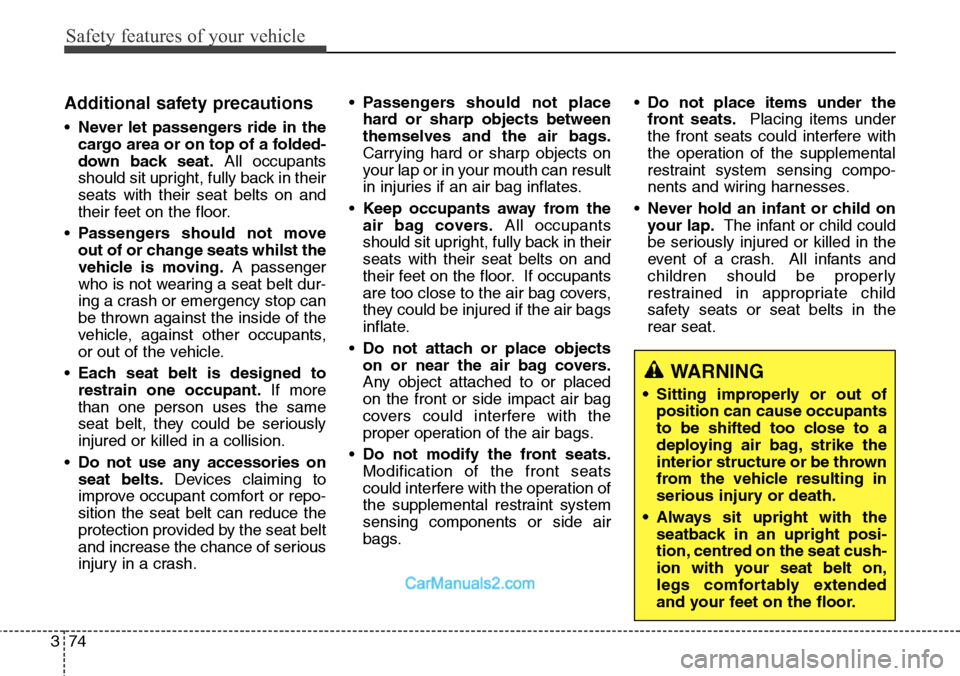
Safety features of your vehicle
74 3
WARNING
• Sitting improperly or out of
position can cause occupants
to be shifted too close to a
deploying air bag, strike the
interior structure or be thrown
from the vehicle resulting in
serious injury or death.
• Always sit upright with the
seatback in an upright posi-
tion, centred on the seat cush-
ion with your seat belt on,
legs comfortably extended
and your feet on the floor.
Additional safety precautions
•Never let passengers ride in the
cargo area or on top of a folded-
down back seat.All occupants
should sit upright, fully back in their
seats with their seat belts on and
their feet on the floor.
•Passengers should not move
out of or change seats whilst the
vehicle is moving.A passenger
who is not wearing a seat belt dur-
ing a crash or emergency stop can
be thrown against the inside of the
vehicle, against other occupants,
or out of the vehicle.
•Each seat belt is designed to
restrain one occupant.If more
than one person uses the same
seat belt, they could be seriously
injured or killed in a collision.
•Do not use any accessories on
seat belts.Devices claiming to
improve occupant comfort or repo-
sition the seat belt can reduce the
protection provided by the seat belt
and increase the chance of serious
injury in a crash.•Passengers should not place
hard or sharp objects between
themselves and the air bags.
Carrying hard or sharp objects on
your lap or in your mouth can result
in injuries if an air bag inflates.
•Keep occupants away from the
air bag covers.All occupants
should sit upright, fully back in their
seats with their seat belts on and
their feet on the floor. If occupants
are too close to the air bag covers,
they could be injured if the air bags
inflate.
•Do not attach or place objects
on or near the air bag covers.
Any object attached to or placed
on the front or side impact air bag
covers could interfere with the
proper operation of the air bags.
•Do not modify the front seats.
Modification of the front seats
could interfere with the operation of
the supplemental restraint system
sensing components or side air
bags.•Do not place items under the
front seats.Placing items under
the front seats could interfere with
the operation of the supplemental
restraint system sensing compo-
nents and wiring harnesses.
•Never hold an infant or child on
your lap.The infant or child could
be seriously injured or killed in the
event of a crash. All infants and
children should be properly
restrained in appropriate child
safety seats or seat belts in the
rear seat.